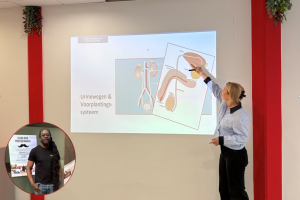Over the past year, researchers at the NKI Center for Early Diagnostics have been investigating a new, more patient-friendly method to assess the risk of prostate cancer in men with elevated PSA levels. The first promising results of this study were recently published in the scientific journal The Prostate.
Risk assessment
The size of the prostate plays an important role in estimating the risk of prostate cancer. Prostate size is usually measured by transrectal ultrasound, an ultrasound scan performed via the rectum. This study focuses on finding a less invasive and more efficient way to determine prostate volume.
Technical physician and PhD researcher Liza Kurucz explains: “We wanted to find out whether prostate volume, and as a result, prostate cancer risk, can be measured just as reliably with an abdominal ultrasound as with a rectal ultrasound or MRI. Our recently published results show that this is indeed possible. This represents an important step toward a more patient-friendly diagnostic approach.”
Artificial Intelligence
To further improve early detection of prostate cancer, the Center for Early Diagnostics is now developing an AI model that automatically calculates prostate volume based on an abdominal ultrasound. This will allow prostate volume to be determined earlier and more easily in the future, helping doctors make better-informed decisions.
Looking ahead
Liza continues: “In the coming years, we aim to further integrate AI and ultrasound, and intend to test these models in the clinic. Our ultimate goal is to assess prostate cancer risk more accurately at an earlier stage, preventing unnecessary and burdensome procedures.”
Photo: Technical physician and PhD researcher Liza Kurucz
References:
Natali, Tiziano et al. “Automatic prostate volume estimation in transabdominal ultrasound images.” European journal of radiology vol. 191 (2025): 112274. doi:10.1016/j.ejrad.2025.112274
Kurucz, Liza M et al. “Prostate Volume and PSA-Density Estimation by Transabdominal Ultrasound: Prospective Evidence of Comparative Accuracy to MRI and Transrectal Ultrasound in Prostate Cancer Early Diagnostics.” The Prostate, 10.1002/pros.70036. 18 Aug. 2025, doi:10.1002/pros.70036








